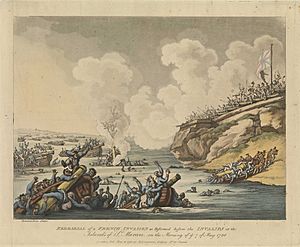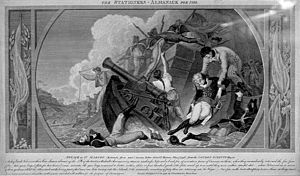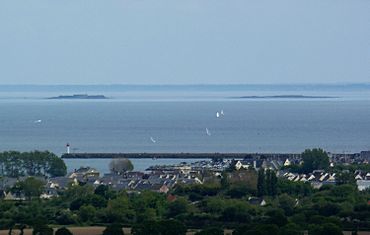Battle of the Îles Saint-Marcouf facts for kids
Quick facts for kids Battle of the Îles Saint-Marcouf |
|||||||
|---|---|---|---|---|---|---|---|
| Part of the naval operations during the War of the First Coalition | |||||||
 Rehearsal of a French Invasion as Performed before the Invalids at the Islands of St Marcou on the Morning of ye 7 of May 1798, Thomas Rowlandson |
|||||||
|
|||||||
| Belligerents | |||||||
| Commanders and leaders | |||||||
| Strength | |||||||
| 500 | 5,000 50 landing craft 6 gunboats |
||||||
| Casualties and losses | |||||||
| 5 killed and wounded | 1,200 killed and wounded 500 captured 6 landing craft destroyed 1 gunboat destroyed |
||||||
The Battle of the Îles Saint-Marcouf was an important fight at sea. It happened near the Îles Saint-Marcouf (Islands of Saint-Marcouf) off the coast of Normandy, France. This battle took place in May 1798 during the French Revolutionary Wars.
The main goal for the French was to remove a British army group from the islands. This group had been there since 1795. The islands were important because they helped the Royal Navy (British Navy) resupply its ships. These ships were watching French waters. The French also wanted to test new equipment and battle plans. They hoped these would help them invade Britain.
On May 7, French forces launched a huge attack by sea. They used over 50 landing ships and thousands of soldiers. The island's 500 British defenders had to fight alone. Strong winds and tides stopped other Royal Navy ships from helping. Even with many more soldiers, the French attack failed completely. The landing ships faced heavy fire from British guns on shore. Royal Marine soldiers also fired at them. This stopped any French soldiers from landing. Nearly 1,000 French soldiers died in their ships. As the French retreated, more were killed by fire from the smaller northern island. The British had very few casualties. After the French failed, the British closely watched the French ports. This led to another success a month later. A French frigate (warship) and a corvette (smaller warship) were captured.
Contents
Why the Battle Happened: Background Story
British Control of the Islands
During the French Revolutionary Wars, British warships sailed along the French coast. They stopped French ships and blocked French ports. In 1795, Captain Sir Sidney Smith of the Royal Navy saw a good idea. He realized that if supply points were set up on islands near France, British ships could stay at sea longer.
So, Smith took control of the empty Îles Saint-Marcouf. These islands are about 3.5 nautical miles (6.5 km) off Ravenoville in Normandy. Smith built living areas and gun batteries there. He put 500 sailors and Royal Marines on the islands. Many of these men were "invalids," meaning they were not fit for long trips on ships.
The Royal Navy regularly brought food to the islands from Britain. Ships also brought bags of earth. This allowed the soldiers to grow a vegetable garden. Smith also had several gunboats to protect the islands. These included Badger, Hawke, Shark, and Nancy. He also had a special floating battery called Sandfly.
French Plans for Invasion
After France won a big victory in Italy in 1796, people in France wanted to attack Britain directly. General Napoleon Bonaparte was first given command of an army called the Armée d'Angleterre (Army of England). Later, General Kilmaine took over. Both generals planned to invade Britain.
Captain Muskein, a naval officer from Antwerp, was told to build a fleet of landing craft. These boats would carry troops across the English Channel. A Swedish ship designer, Fredrik Henrik af Chapman, created the plans for these invasion barges. By 1797, these boats were being built along the northern French coast. French soldiers called them "bateaux à la Muskein" (Muskein-type boats).
In April 1798, Muskein was ordered to prepare his barges. They were to attack the Saint Marcouf Islands. This attack had several goals:
- To remove the British soldiers from the islands.
- To test how well the new barges worked in a real battle.
- To make the British navy focus on the English Channel. This would distract them from Bonaparte's plans to invade Egypt from Toulon.
On April 7, 1798, Muskein sailed from Le Havre with 33 barges. General Point was in command. But on April 8, British frigates blocked their way. These were HMS Diamond (Captain Sir Richard Strachan) and HMS Hydra (Captain Sir Francis Laforey). The frigates trapped the barges near the River Orne and started firing. Diamond got stuck in the mud, but neither side caused much damage.
On April 9, the French boats left the Orne River. They anchored in the harbor of Bernières-sur-Mer. But then the British ship HMS Adamant arrived. This made Muskein go back to the safer Orne mouth. As he returned, Diamond and Hydra fired at him again. The French boats then hid under the guns at Sallenelles to fix their damage.
Over the next two weeks, things changed. Rear-Admiral Jean Lacrosse in Cherbourg heard about Muskein's problems. He sent 40 more barges and armed fishing boats to Sallenelles. In late April, Muskein found a chance to escape. He sailed to Saint-Vaast-la-Hougue, west of the islands. There, he waited for the perfect weather. He needed calm winds and weak tides. This would allow his attack to happen without the British ships stopping him.
The Battle Begins: French Attack on the Islands
Setting the Stage for Battle
On May 6, the weather was perfect for Muskein's attack. The calm winds meant British warships could not reach his boats. The weak tides kept his small boats steady. The British also knew these conditions were right for an attack. They quickly prepared their guns and lined the shore with Royal Marines.
A small boat from the islands watched Muskein's force. They saw the French boats rowing out of Saint-Vaast-la-Hougue. They slowly moved closer to the islands during the evening. The British ship HMS Eurydice and the brig HMS Orestes had joined Adamant. But Adamant was stuck 6 nautical miles (11 km) away because of the calm winds. Even with great effort, these three ships could not reach the islands in time to help.
The French Assault
At midnight, the island's boat signaled that the French were coming. Lieutenant Price got the defenses ready. Muskein's force had 52 vessels. This included several large gun-brigs. These brigs had big cannons and were meant to fire at the British while the landing boats moved in. The main group of French soldiers was between 5,000 and 6,000 men. They were mostly from coastal defense units near Boulogne.
Muskein did not want to attack at night. So, he waited until dawn. He used the darkness to get his boats into position. They faced the western defenses of the southern island. The gun-brigs stayed about 300 yards (270 m) offshore. They were behind the landing barges. As dawn broke, Muskein ordered the attack. The gun-brigs and smaller cannons on the barges began firing at the British defenses.
The West Island's guns, led by Lieutenant Price, had 17 cannons. Some were small, but others were very powerful. These guns caused terrible damage to the light French invasion boats. Even with many losses, the French barges kept coming. They got within musket range, about 50 yards (46 m). The Royal Marine soldiers on the island started firing. The artillery crews switched to canister shot, which is like a giant shotgun blast. Six or seven French boats sank with everyone on board. Many others were badly damaged.
The French losses were so high that they called off the attack. But the journey back was still dangerous. The barges had to pass East Island. This island was commanded by Lieutenant Richard Bourne. It had two huge 68-pounder carronades. These massive guns caused even more severe losses to the French. Even though Hotham's British ships tried hard to reach the battle, the wind was too light. They could only chase the remaining French ships back into Saint-Vaast-la-Hougue.
What Happened Next: Aftermath of the Battle
French Losses and Reaction
The battle was a huge disaster for the French. Unofficial reports say they lost about 900 men killed or drowned. At least 300 more were wounded. They also lost many of their newly built landing craft.
In France, the new Minister of Marine Étienne Eustache Bruix ordered a second attack on the islands. But the French Directory, which was the government, quickly stopped these orders. They did not want another embarrassing failure. Instead, Admiral Lacrosse ordered most of the surviving ships to Cherbourg. Some later went to Saint Malo and Granville. Muskein was told to return to Le Havre with the rest.
British Victory and Legacy
In Britain, the successful defense of the islands was highly praised. Lieutenant Price was promoted as a reward. British losses were very small: only one marine killed and four others wounded. The victory made Britons feel safer. They saw it as a sign of what would happen if France tried to invade Britain.
Almost 50 years later, the British Navy gave out a special medal. It was called the Naval General Service Medal with the "Isles St. Marcou" clasp. This was given to any British participants who were still alive and applied for it.
The British made the islands' defenses stronger. They wanted to be ready for any future attacks. Several warships patrolled the area. They watched French movements and tried to stop any invasion fleets. This strategy led to an unexpected success on May 30, 1798. HMS Hydra caught the French frigate Confiante and a corvette near the Dives River. The British forced Confiante ashore. Later, British soldiers went aboard and burned her.
The islands stayed under British control without any more French attacks until 1802. The Peace of Amiens treaty then returned the islands to French control. During the Napoleonic Wars (1803–1815), the islands remained French. They were protected by a large group of soldiers.
Images for kids
-
Rehearsal of a French Invasion as Performed before the Invalids at the Islands of St Marcou on the Morning of ye 7 of May 1798, Thomas Rowlandson








